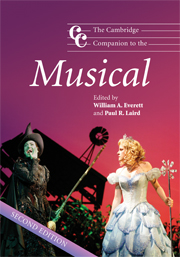Book contents
- Frontmatter
- Part I Adaptations and transformations: before 1940
- Part II Maturations and formulations: 1940–1970
- Part III Evolutions and integrations: after 1970
- 11 Stephen Sondheim and the musical of the outsider
- 12 Choreographers, directors and the fully integrated musical
- 13 From Hair to Rent: is ‘rock’ a four-letter word on Broadway?
- 14 The megamusical: the creation, internationalisation and impact of a genre
- 15 ‘Something borrowed, something blue’: the marriage of the musical and Europe
- 16 New horizons: the musical at the dawn of the twenty-first century
- Part IV Legacies and transformations
- Notes
- Select bibliography
- Index
11 - Stephen Sondheim and the musical of the outsider
from Part III - Evolutions and integrations: after 1970
Published online by Cambridge University Press: 28 September 2011
- Frontmatter
- Part I Adaptations and transformations: before 1940
- Part II Maturations and formulations: 1940–1970
- Part III Evolutions and integrations: after 1970
- 11 Stephen Sondheim and the musical of the outsider
- 12 Choreographers, directors and the fully integrated musical
- 13 From Hair to Rent: is ‘rock’ a four-letter word on Broadway?
- 14 The megamusical: the creation, internationalisation and impact of a genre
- 15 ‘Something borrowed, something blue’: the marriage of the musical and Europe
- 16 New horizons: the musical at the dawn of the twenty-first century
- Part IV Legacies and transformations
- Notes
- Select bibliography
- Index
Summary
In a New York Times Magazine interview with Frank Rich, Stephen Sondheim (b. 1930) told an anecdote as revealing as it was charming. Reminiscing about the New Haven opening of Carousel in 1945, when he was fifteen, the composer/lyricist recalled the emotional impact of the first act's closing moments. ‘I remember how everyone goes off to the clambake at the end of Act One and Jigger just follows, and he was the only one walking on stage as the curtain came down. I was sobbing.’ In the next paragraph, however, Sondheim displays a more characteristic caginess when considering why Carousel is his second favourite score. (Porgy and Bess is his favourite.) After suggesting that he might be drawn to Carousel ‘because it's about a loner [the protagonist Billy Bigelow] who's misunderstood’, Sondheim dismisses the thought, calling it ‘psychobabble’. Later in the interview, he returns to this somewhat defensive argument, noting that, after all, ‘the outsider is basic to a lot of dramatic literature. This country's about conformity. And so nonconformity is a fairly common theme.’
Non-conforming outsiders are indeed inherent in much dramatic literature. American musicals, however, have generally avoided them, and certainly their presence as protagonists in musicals before Carousel is rare. Even their existence as important supporting characters is unusual. Notable exceptions exist, of course. They include the mulatto Julie in Show Boat (1927), the discovery of whose racial heritage results in her dismissal from the showboat company and her subsequent tragedy, and Jud Fry in Oklahoma! (1943), whose angry isolation is voiced in the disturbing number ‘Lonely Room’. With the possible exceptions of Pal Joey (1940) and the opera-derived Carmen Jones (1943), however, musicals before Carousel were not about these outsiders.
- Type
- Chapter
- Information
- The Cambridge Companion to the Musical , pp. 203 - 219Publisher: Cambridge University PressPrint publication year: 2008



